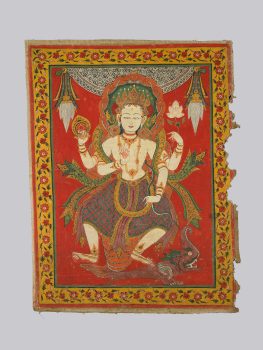Nepal
17th or 18th century


Nepal
17th or 18th century


This double-sided banner shows two matrika, mother goddesses that represent the female counterparts of the great Hindu gods and the embodiments of those gods’ energies (shakti). The white matrika is Varuni, the goddess of the water, symbolized by the multiple snakes that form a hood above her head, the mythical water monster (makara) she dances on, and the lotus and serpent she holds in her hands. The red matrika Varahi on the reverse is the female aspect of the Hindu boar god Varaha, who is an avatar of the great god Vishnu.The body of each god is emphasized through the use of a contrasting background color. They are both represented under a canopy with tassels hanging from the sides. Their patterned skirt-like garments (dhoti), flowing ribbons, and five-petaled crowns are all characteristic of Nepalese painting. Banners such as this were used in religious processions and were a part of larger sets.
A kind of energy that can be used, individually and collectively, to effect change.
In Buddhism gender is considered more fluid compared to some other religions. Certain traditions emphasize the importance of all genders in achieving enlightenment. The feminine is considered an embodiment of wisdom and the masculine is an embodiment of method.
Buddhist practitioners in some traditions believe that cutting through ordinary perceptions that keep us in the endless cycle of death and rebirth, known as samsara, can create a powerful and enhanced divine identity that leads to enlightenment.
Hindu gods (deva) are thought to be manifestations of the absolute, or Brahman. The goddesses (devi) are considered manifestations of the Great Mother Goddess (Mahadevi), who is seen as the counterpart to Brahman.
The Himalayan kingdoms of the Kathmandu Valley were significant centers of Buddhist culture. Nepalese kings, Buddhist institutions, and ordinary people patronized the vibrant art guilds. The artistic traditions of the regions are well-known in Tibetan areas and beyond, and Newar artists have always been in high demand throughout Tibetan regions and Inner Asia.
Get the latest news and stories from the Rubin, plus occasional information on how to support our work.